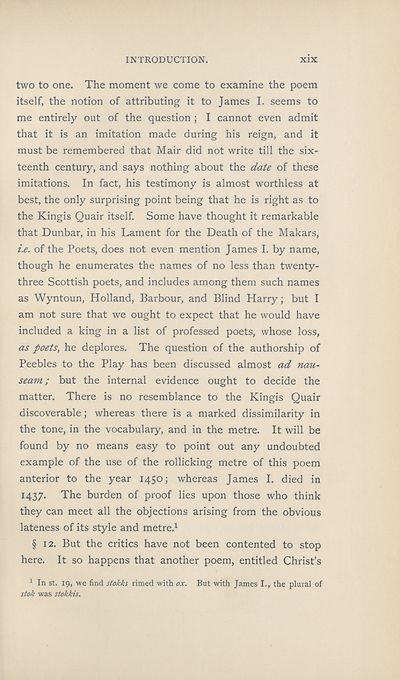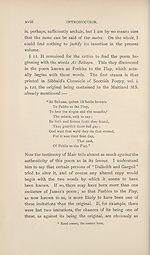Scottish Text Society publications > New series > Kingis quair; together with A ballad of good counsel
(29)
Download files
Complete book:
Individual page:
Thumbnail gallery: Grid view | List view

INTRODUCTION.
XIX
two to one. The moment we come to examine the poem
itself, the notion of attributing it to James I. seems to
me entirely out of the question ; I cannot even admit
that it is an imitation made during his reign, and it
must be remembered that Mair did not write till the six¬
teenth century, and says nothing about the date of these
imitations. In fact, his testimony is almost worthless at
best, the only surprising point being that he is right as to
the Kingis Quair itself. Some have thought it remarkable
that Dunbar, in his Lament for the Death of the Makars,
i.e. of the Poets, does not even mention James I. by name,
though he enumerates the names of no less than twenty-
three Scottish poets, and includes among them such names
as Wyntoun, Holland, Barbour, and Blind Harry; but I
am not sure that we ought to expect that he would have
included a king in a list of professed poets, whose loss,
as poets, he deplores. The question of the authorship of
Peebles to the Play has been discussed almost ad nau¬
seam; but the internal evidence ought to decide the
matter. There is no resemblance to the Kingis Quair
discoverable; whereas there is a marked dissimilarity in
the tone, in the vocabulary, and in the metre. It will be
found by no means easy to point out any undoubted
example of the use of the rollicking metre of this poem
anterior to the year 1450; whereas James I. died in
1437. The burden of proof lies upon those who think
they can meet all the objections arising from the obvious
lateness of its style and metre.1
§ 12. But the critics have not been contented to stop
here. It so happens that another poem, entitled Christ’s
1 In st. 19, we find stokks rimed with ox. But with James I., the plural of
stok was stokkis.
XIX
two to one. The moment we come to examine the poem
itself, the notion of attributing it to James I. seems to
me entirely out of the question ; I cannot even admit
that it is an imitation made during his reign, and it
must be remembered that Mair did not write till the six¬
teenth century, and says nothing about the date of these
imitations. In fact, his testimony is almost worthless at
best, the only surprising point being that he is right as to
the Kingis Quair itself. Some have thought it remarkable
that Dunbar, in his Lament for the Death of the Makars,
i.e. of the Poets, does not even mention James I. by name,
though he enumerates the names of no less than twenty-
three Scottish poets, and includes among them such names
as Wyntoun, Holland, Barbour, and Blind Harry; but I
am not sure that we ought to expect that he would have
included a king in a list of professed poets, whose loss,
as poets, he deplores. The question of the authorship of
Peebles to the Play has been discussed almost ad nau¬
seam; but the internal evidence ought to decide the
matter. There is no resemblance to the Kingis Quair
discoverable; whereas there is a marked dissimilarity in
the tone, in the vocabulary, and in the metre. It will be
found by no means easy to point out any undoubted
example of the use of the rollicking metre of this poem
anterior to the year 1450; whereas James I. died in
1437. The burden of proof lies upon those who think
they can meet all the objections arising from the obvious
lateness of its style and metre.1
§ 12. But the critics have not been contented to stop
here. It so happens that another poem, entitled Christ’s
1 In st. 19, we find stokks rimed with ox. But with James I., the plural of
stok was stokkis.
Set display mode to: Large image | Zoom image | Transcription
Images and transcriptions on this page, including medium image downloads, may be used under the Creative Commons Attribution 4.0 International Licence unless otherwise stated. ![]()
| Publications by Scottish clubs > Scottish Text Society publications > New series > Kingis quair; together with A ballad of good counsel > (29) |
|---|
| Permanent URL | https://digital.nls.uk/113908643 |
|---|
| Description | A collection of over 100 Scottish texts dating from around 1400 to 1700. Most titles are in Scots, and include editions of poetry, drama, and prose by major Scottish writers such as John Barbour, William Dunbar, Gavin Douglas, and George Buchanan. Edited by a key scholarly publisher of Scotland's literary history, and published from the late 19th century onwards by the Scottish Text Society. Available here are STS series 1-3. |
|---|

